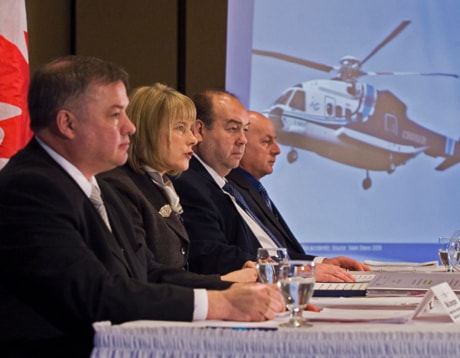ST. JOHN’S, N.L. — A Transportation Safety Board report into a deadly helicopter crash off Newfoundland recommends grounding flights over seas that are too rough for a survivable emergency landing.
The board’s chairwoman, Wendy Tadros, said Wednesday that all Sikorsky S-92 helicopters should be able to run dry without lubrication in their main gearboxes for at least 30 minutes.
She also said the Federal Aviation Administration in the United States should look at harsh operating environments and decide whether the gearboxes should be able to operate for longer than 30 minutes without oil.
“All S-92A helicopters should be able to ’run dry’ for at least 30 minutes. That’s key,” Tadros told a news conference in St. John’s.
“In addition, we want the FAA to look at today’s operating environments — Hibernia, the Arctic, the North Sea, any of these extreme locations — and decide whether even 30 minutes is enough time.”
The U.S. agency declined an interview but in an email statement it said it will respond to the report “in a timely manner.”
The safety board had already said that the failure of titanium studs that secured the oil filter bowl assembly to the helicopter’s main gearbox caused a loss of oil pressure before Cougar Flight 491 crashed into the North Atlantic on March 12, 2009.
The FAA said it has issued directives calling for more bolts to secure the filter assembly of the gearbox and for stepped up inspections of the components.
“We continue to monitor the S-92’s in-service performance and will take any actions needed to maintain safety,” it says in the news release.
Seventeen people who were on their way to Newfoundland’s offshore oilfields were killed in the crash.
The sole survivor, Robert Decker, was rescued after a narrow escape from the wreckage. He endured 75 minutes on the frigid ocean surface in a leaking survival suit as he waited for help.
Mike Cunningham, who led the investigation for the board, said those who died were alive when the helicopter crashed, and flotation collars meant to keep the aircraft from sinking never deployed.
“The helicopter had a 2,300 foot per minute rate of descent. From this height the helicopter fell at a severe impact with the surface. The impact disabled the emergency flotation system and the helicopter sank quickly,” he said.
“Due to the crash-worthy features of the S-92, all 18 people survived the initial impact with the water. However, only two of the helicopter’s occupants escaped the wreckage and, as we know, only one of those folks survived.”
The board makes four key safety recommendations in its final report.
“If the sea state is too rough for a successful emergency ditching, then a helicopter shouldn’t be operating. Period,” Tadros said.
The board also calls for emergency air supply on “all helicopter flights that require survival suits, not just those off Newfoundland.”
The pilots reported a loss of oil pressure in the chopper’s main gearbox about 11 minutes before they hit the water. They turned back for land and told passengers they were ditching just before plunging into the sea about 55 kilometres east of St. John’s.
The main gearbox and its ability to run without lubricant for a 30-minute period became a central question in the aftermath of the crash.
The board confirmed in 2009 that two of three titanium studs that secure the oil filter bowl assembly to the helicopter’s main gearbox broke in flight, causing the loss of oil pressure. Oil is essential to grease the gears that power the aircraft’s rotor drive, maintaining control in the air.
Those studs have since been replaced with steel parts on other Sikorsky S-92 helicopters.
The report’s analysis says Sikorsky’s marketing materials “indicated” the helicopter had the ability to fly for 30 minutes after the loss of oil, known as the “run-dry” capability.
Though the company changed its wording after failing an initial test, the board’s report says it still was “close enough to the original wording ... to potentially lead some to believe that the S-92 had a 30-minute run-dry capability.”
The board’s final report also says the pilots didn’t indicate how much time they thought they had before the gearbox would stop working.
“At no time did either of the occurrence pilots make a comment which would indicate that they believe the S-92 main gearbox had a run-dry capability,” says the report.
The report says in the analysis that if such “critical information” isn’t in manuals, “there is an increased risk that pilots will make decisions based on incomplete or inaccurate information” during emergencies.
Without that formal guidance, the report says, the pilots relied on “previously learned information or their best guess” on how long they could stay in the air.
The report also says they “hypothesized” an oil pressure sensor had malfunctioned, or that an oil pump had failed.
The board’s analysis says the emergency procedures were “ambiguous and lacked clearly defined symptoms of a complete loss of main gearbox oil.”
The report says the crew misunderstood the peril they were in and that delayed their decision to ditch into the sea.
Cougar Helicopters Inc. declined comment but said in a news release that it will review the report and its supporting documents. It says it has installed a redesigned main gearbox on the helicopter and uses more attachment studs to ensure the oil filter stays on.
The company says it updated and improved the emergency check list that pilots use when they’re flying the helicopter over the North Atlantic.
Mark Clitsome, the safety board’s director of air investigations, noted that following an Australian incident in July 2008, notifications were sent to operators of the S-92 to increase inspections and maintenance of the studs holding the oil filter.
He told the board’s news conference that Cougar hadn’t performed the maintenance as they awaited the arrival of new steel studs.
“This meant damaged studs were neither detected nor replaced,” he said.
